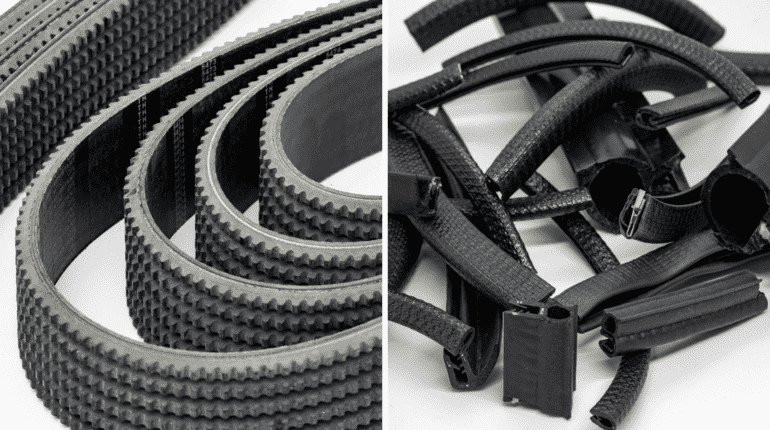Table of contents
- 1 What is neoprene rubber?
- 2 When was neoprene invented?
- 3 Why use neoprene over natural rubber
- 4 Grades of neoprene rubber
- 5 Application of neoprene rubber across various industries
- 6 Material properties
- 7 Are there any disadvantages of using neoprene rubber?
- 8 Factors to consider while choosing neoprene rubber
What is neoprene rubber?
Neoprene is a family of synthetic rubbers produced by polymerization of chloroprene. It is also known as polychloroprene because both refer to the same family of synthetic rubber. This type of rubber shows remarkable physical and chemical properties. Neoprene is waterproof, thermally stable, and chemically resistant. It is also known for its oil-resistant properties.
Neoprene’s durability and resistance to water and temperature shifts make it special and unique. It is soft and flexible and can be used in packaging, medical, and safety industries. Neoprene rubber plays a significant role in the automotive industry, leveraging its exceptional qualities such as resistance to oils, chemicals, and various weather conditions, including sunlight, ozone, and rain. This makes it highly suitable for a multitude of automotive applications:
Hoses and belts: Employed in the creation of various hoses (e.g., radiator, fuel, and air conditioning hoses) and belts (serpentine and timing belts), neoprene’s resistance to temperature fluctuations and chemicals extends the lifespan of these automotive components.
Gaskets and seals: Neoprene’s sealing capabilities, particularly against oils and chemicals, make it an excellent choice for engine, transmission, and other system gaskets and seals, preventing fluid and gas leaks.
Mounting and suspension: Due to its vibration dampening properties and resistance to compression and deformation, neoprene is used in mounting parts and suspension components like bushings and shock absorber seals.
Weather stripping and door seals: It’s utilized in weather stripping and door seals to insulate the vehicle, reduce noise, and prevent the entry of water and dust, thus protecting the vehicle’s interior from external elements.
Insulation: The thermal and electrical insulation properties of neoprene make it suitable for wiring insulation and protecting other sensitive vehicle components.
When was neoprene invented?
Neoprene rubber was developed in 1930 by DuPont company scientists. It is also known as polychloroprene. It was one of the first synthetic rubbers. It is resistant to oil, fuel, extreme weather, and water, making it best suited for products in many different industries (electrical, mechanical, construction, etc.)
Why use neoprene over natural rubber
Neoprene rubber vs natural rubber
|
Properties |
Neoprene rubber |
Natural rubber |
|
Resistant to oil and grease |
✔ |
✗ |
|
Temperature tolerance |
✔ |
✗ |
|
Compressibility |
✔ |
✗ |
|
Liquid resistant |
✔ |
✗ |
|
Resistance to ozone and oxidation |
✔ |
✗ |
|
Cost |
✗ |
✔ |
|
Resistance to strong acids |
✗ |
✗ |
Grades of neoprene rubber
There are various grades of neoprene available in the market. Categorization is based on the composition of a neoprene rubber sheet. For more information about rubber products, contact Formgummigruppen through their website.
Commercial grade neoprene
Commercial-grade neoprene has a 13% neoprene base and it is a blend of neoprene and other rubbers. This grade is suitable for general gasket applications but it is not recommended for applications where more oil resistance is needed.
Medium grade neoprene
Medium-grade neoprene is a blend of 51% neoprene base and other rubbers. It doesn’t have high tensile strength and is used for general purposes.
High-grade neoprene
High-grade neoprene is 100% neoprene with no other rubber mixture. It has high tensile strength and excellent pressure resistance. Due to its properties, high-grade neoprene rubber could be used in marine applications because it is resistant to oil, fuel, and saltwater.
Flame retardant neoprene
Flame-retardant neoprene rubbers are specially formulated to resist combustion. This grade of neoprene is best suited for applications requiring fire resistance, such as electrical equipment, transportation, oil tankers, gas and oil filling stations, and construction.
FDA-approved neoprene grade
FDA-approved neoprene rubber is specially manufactured for applications in the food and pharmaceutical industry. This rubber grade is approved by the United States Food and Drug Administration (FDA). It is non-toxic, odorless, tasteless, and resistant to bacteria and fungi.
Application of neoprene rubber across various industries
There are various industries where products manufactured from neoprene are being used. Some of these industries are listed below:
Automotive industry
Neoprene rubber sheets are used in the automotive industry to manufacture gaskets, seals, hoses, and vibration dampers. These rubbers provide airtight and leak-free seals.
Neoprene’s resistance to oil, fuel, and heat makes it the best material for manufacturing hoses and belts. It can also absorb and dissipate vibration, that’s why it is used to manufacture vibration dampers.
Electrical industry
In the electrical industry, neoprene is used as an insulator for wiring cables because of its heat and combustion resistant properties. It is also used in electrical connectors and sealing applications. The benefit of using it would be a reliable and moisture-resistant connection.
Construction industry
The construction industry uses Neoprene rubber sheets for waterproofing, sealing, and insulation. They can create watertight seals around windows, doors and in expansion joints to accommodate thermal expansion and contraction in building structures.
Marine & aquatic
Neoprene rubber sheets are used in the marine industry to manufacture gaskets, seals, and protective covers. Neoprene is resistant to saltwater, pressure, extreme weather, oil, fuel, and UV traditions, making it the best fit for marine products.
Neoprene sheet is also used to manufacture bumpers and fenders. These absorb energy from shocks and knocks and limit the damage to the vessel.
Sports and recreational equipment
Neoprene rubber is also used to manufacture the products in the sports industry.
These products are manufactured because of the neoprene’s water and pressure resistance. Because of its property of shock absorption, it is used to manufacture protective gears
- Diving (wetsuits, Diving drysuits, gloves, boots)
- Protective gear (Knee pads, elbow pads, and helmets) due to shock absorbent properties
Medical industry
The products manufactured in the medical industry by neoprene rubbers include
braces, support, orthopedic devices, personal protective equipment (PPE), padding for wrist
knee brace padding, prosthetic limbs, and orthotic insoles.
Neoprene rubber is flexible and elastic, making it the best choice for the medical industry. Products manufactured with this material provide patients with support, protection, and comfort.
Aerospace & defense
The rubber products manufactured in the aerospace industry include bumpers, hatch seals, covers, rubber grommets, rubber extrusion, extruded tubing, seals, protective boots, elbows, and O-ring seals.
Material properties
- Ozone resistance
- Weather resistance
- Abrasion resistance
- Shock absorption
- Flame resistance
- Chemical substance resistance
- Heat resistance
- Oil resistance
- Diluted acid resistance
- Easy adhesion
- Wear and tear resistance
- Water resistance
- Tensile strength
- Impact resistant
- Vibration isolation
- Cold resistant
Are there any disadvantages of using neoprene rubber?
Neoprene has few practical limitations. It is slightly higher in price than general-purpose synthetic rubber. Its resistance to ozone, oil, and chemicals makes it cost-effective in specific applications.
Neoprene rubber offers poor resistance to strong oxidizing acids, esters, ketone, choliranted, aromatic, and nitro hydrocarbons. When oxidized, it starts showing these physical properties swelling, hardening, cracking, color change, and loss of mechanical properties.
How products are manufactured from neoprene
Neoprene rubbers come in rolls, sheets, and fabric at manufacturing plants. Different shapes and products are manufactured from this shape. In a manufacturing plant, it can be molded and extruded into different types. Read more
Some of the types are listed below:
- Solid
- Sponge
- Foam rubber (closed cell and open cell)
Closed-cell neoprene rubber is waterproof. In contrast, open-cell neoprene allows gas and fluids to pass through. From these types of rubber, further products are made.
Some examples are listed below:
- Wire and cable insulation
- Belts
- Springs
- Flexible mounts
- Gaskets
- Adhesives
Factors to consider while choosing neoprene rubber
Depending on your needs and application, several factors must be considered while choosing neoprene rubber sheets. The right choice of sheet can ensure longevity, efficiency, optimal performance, and cost-effectiveness. The wrong choice of neoprene rubber would probably not meet your requirements and would still cost you quite a lot of money. An informed decision about the type of neoprene could save time and money.
Temperature
Different neoprene grades offer different ranges of temperature resistance. You have to select the one that best suits your needs.
Chemical compatibility
Neoprene rubber sheets exhibit resistance to various chemicals, but that depends on the grade. You must check which chemical the neoprene rubber sheet would be exposed to in your case. Then, select a particular grade of neoprene rubber that is compatible with that chemical.
Physical properties
Neoprene rubber sheets offer various physical properties, such as tensile strength, elongation, wear and tear resistance, and hardness. It would be best to look for the neoprene grade that shows these properties according to your needs.
Weather resistant
Neoprene rubber sheets resist ozone, oxidizing agents, UV radiation, water, and pressure. Different grades of neoprene offer environmental resistance in different ranges. You have to select the grade that meets your specifications.
Industry compliance
Industries like pharmaceutical, electrical, automotive, and food have regulatory compliances that neoprene rubber sheets must meet. You have to ensure that specific grades comply with industry standards. For example, FDA-approved neoprene is designed for the food and pharma industry. Flame retardant neoprene sheets meet fire safety standards.








